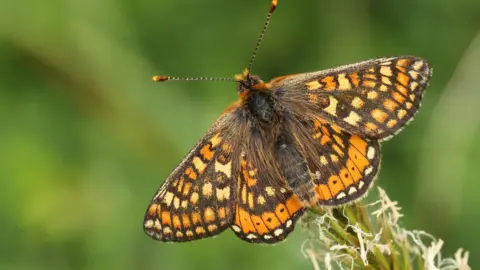 Vaughn Matthews
Vaughn MatthewsA rare butterfly is being reintroduced into the Welsh countryside decades after it disappeared, thanks to a team of conservationists.
Hundreds of marsh fritillary butterflies, with their unmistakeable cream and orange wings, can now be spotted on Llantrisant Common in Rhondda Cynon Taf.
The man behind this resurgence is Rob Parry, the founder of Initiative for Nature Conservation Cymru.
His team took caterpillars from the wild, reared them and released them back into the area – a controversial approach but one he feels is increasingly necessary.
“Many of our species are on the brink, right on the edge, and we can’t afford to monitor them disappearing,” he told BBC Wales Live.
“Once we do that – getting them back is so much harder. That’s why these projects – where we are intervening before they become extinct – is really important.”
According to the latest State of Nature Report almost one in five species in Wales were classed as being at risk of vanishing in years to come.
But why butterflies and why this particular one?
According to Butterfly Conservation UK, butterflies are recognised as indicators of biodiversity and their survival can provide a serious warning about our environment.
“Marsh fritillaries are incredibly rare and we are losing populations in Wales as well as throughout the UK and Europe,” Rob said.
“Wales is still a bit of a stronghold for the butterfly, so it felt right. The marsh fritillary is a bit of an icon here.”
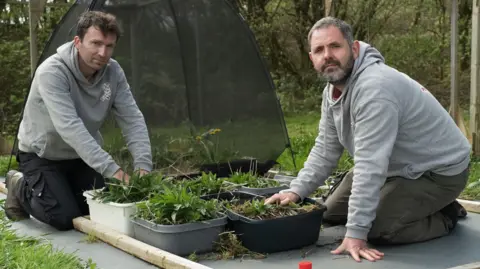
The project has seen butterflies mating and laying eggs on the common.
Vaughn Matthews, who has helped rear and release caterpillars, said it was “an incredible experience” after “20-odd years of there being no marsh fritillaries on there”.
But reintroduction is not without its critics.
Last year, the UK government’s Department for Environment, Food and Rural Affairs said this was not a priority and it aimed to reach biodiversity targets through methods such as habitat restoration.
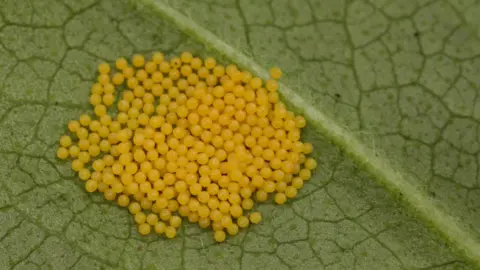 Vaughn Matthews
Vaughn MatthewsNatural Resources Wales rejected Rob’s original project proposal in 2016, which he felt was “a sign of where nature conservation is or was at”.
“A lot of it has been protecting what we’ve already got, monitoring and doing science, research and so on,” he added.
This changed when he resubmitted plans in 2019.
Liz Halliwell from NRW said she understood the role reintroduction could play, but it had to be considered against other options.
“This is one tool in a toolbox of things that we need for species recovery,” she said.
“We need to look first at the causes of the things that have made that species decline or go extinct.
“It’s that balancing act of saying ‘it’s important, let’s do it properly’.”
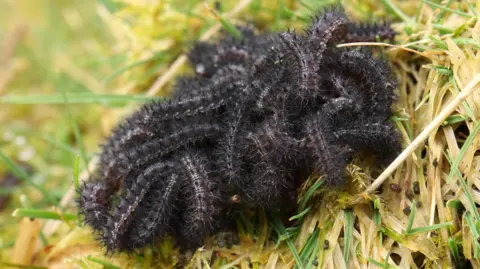 Vaughn Matthews
Vaughn MatthewsShe also points to some of the risks of reintroduction, saying “it is not enough to just get some animals and chuck them out” as there could be risks to native wildlife through competition and disease.
“Habitat restoration would be needed in advance to make sure you’re not releasing animals that are then lost as well,” she added.
The Initiative for Nature Conservation Cymru always intended that the caterpillars’ environment would be at the heart of their plans.
“Although the focus is the butterfly, fundamentally, it’s about getting more habitat in the landscape,” said Rob.
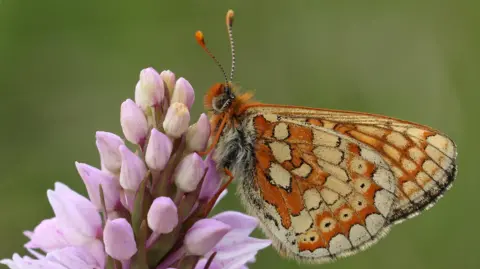 Vaughn Matthews
Vaughn MatthewsThe butterflies thrive on Rhôs Pasture, a distinctive marshy grassland, that is home to a number of different wetland species.
Food production and a movement from cattle grazing to sheep in Wales has led to a lot of this land being drained.
Rob and his team have been working with landowners and communities to help bring the landscape back to life and give their butterflies the best chance of survival.
In response to wider reservations around reintroduction, he said: I would love to see a Wales where we didn’t have to intervene, but that ship sailed decades ago.”
A period of monitoring is the next phase for the project and a team will monitor them over several years with the hope they are able to build the population and thrive.
They then look at other species that might need a helping hand.

